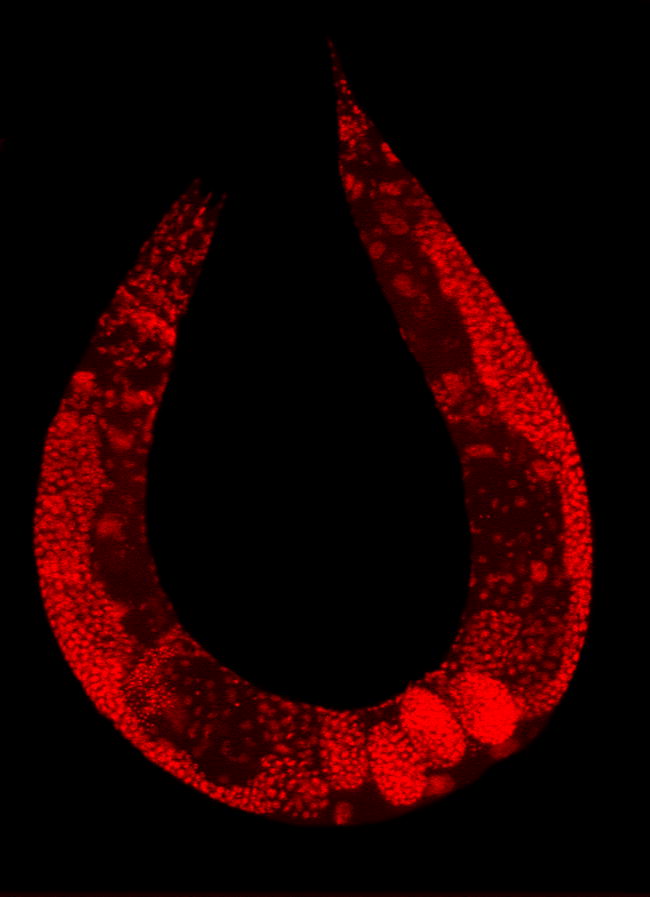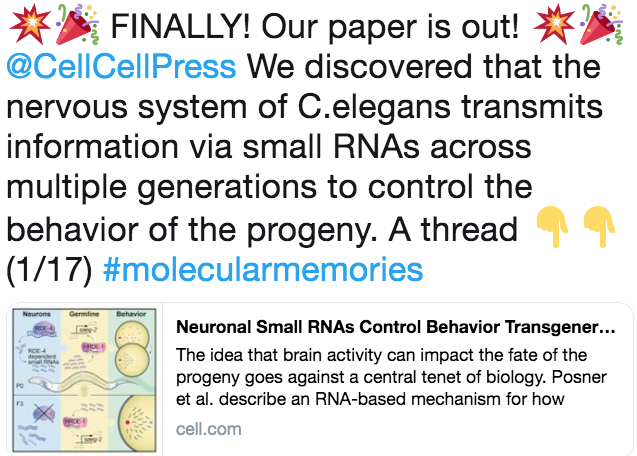
June 14, 2019, by Brigitte Nerlich
Threads, worms and science communication
I thought I had written my last post about epigenetics. But then came along some ‘worms’ and I had to write another one.
I have written about worms once before on the Making Science Public blog, in the context of science communication. And this blog post too will reflect on worms in the context of science communication, but in a slightly different context.
In 2014, when I wrote my first worm post, twitter was eight years old but still evolving. Now we live in a twitterverse where science communicators can use ‘threads’, launched at the end of 2017, to knit together tweets into a science story. Some of the best science communication now happens in ‘threads’. And this is what happened on this occasion.
So what am I talking about? On 6 June a research group working in Tel Aviv around Oded Rechavi published an article in Cell entitled “Neuronal Small RNAs Control Behavior Transgenerationally”. The gist of the article was this, as summarised in the abstract: “In Caenorhabditis elegans nematodes, parental responses can transmit heritable small RNAs that regulate gene expression transgenerationally. In this study, we show that a neuronal process can impact the next generations.”
So the hero of the study is C. elegans, the worm of wonder I had talked about in my previous post, but not in the context of epigenetics. What has this to do with epigenetics?
Worms and epigenetics
Epigenetics is a new field in genetics and genomics, which came to prominence around the year 2000 and about which I have written since 2013. It is still finding its feet and it is still struggling with definitions and concepts. One of the most contested notions is that of ‘transgenerational epigenetic inheritance’. This phenomenon has been observed in plants, worms and some rodents, but there is, as yet, no clear evidence that it exists in mammals/humans.
In an important article summarising some myths surrounding epigenetics, Edith Heard, a renowned epigenetics researcher, pointed out: “Since the human genome was sequenced, the term ‘epigenetics’ is increasingly being associated with the hope that we are more than just the sum of our genes. Might what we eat, the air we breathe, or even the emotions we feel influence not only our genes but those of descendants?” This is at the core of speculations surrounding epigenetics and transgenerational epigenetic inheritance.
The worm study that caught my eye has to be seen in this context. It was announced under headlines such as “Worm parents pass on behaviours epigenetically to offspring”.
Even one of the most sceptical observers of research into transgenerational epigenetic inheritance, Kevin Mitchell, tweeted: “Some real transgenerational epigenetics… (in worms)”.
He also retweeted a ‘thread’ by the group leader, Oded Rechavi, which was a masterpiece of science communication, both verbal and visual – indeed, threading them both creatively together. We’ll come to that in a minute.
Epigenetic worms in the media
How was the study reported in the ‘mainstream media’? I had a quick look and found only four articles, all published in Israeli news outlets. I tracked down a few more on Google News. Here are some of the headlines in the print media: “Israeli study: Nervous system can transmit messages to future generations”; “Israel study says neurons, not just DNA, can affect progeny’s fate”; “Researchers say nervous system passes info to kids”; “Worms help Israeli scientists rewrite basics of genetics”.
Two things struck me: Firstly, the the use of anthropomorphic terms like ‘kids’. This type of language can create the wrong expectations. Secondly, the claim that this study overthrows basic genetics. This claim came also up in an online article on Breaking Israel News entitled “Small worms help Israeli researchers disprove basic dogma of modern biology”.
This article was, I believe, the press release for the Cell study and contains a great artistic illustration of worms. It was picked up by eurekalert, where Rechavi is quoted as saying “It’s important to stress that we don’t know yet whether any of this translates to humans”.
So, firstly, caution is needed when jumping from worms to humans. And secondly, caution is needed when jumping from this study to overthrowing basic biology. In the past, some epigeneticists and philosophers of science have made claims about epigenetics doing just that, claims that were greeted mainly with scepticism by other scientists.
Three other online articles reported on the study, one published in The Scientist and dryly entitled: “Worm parents pass on behaviors epigenetically to offspring”; one in Psychology Today seeing it as ‘disruptive’ to biology and neuroscience, and one in the Big Think linking it to ‘reincarnation’ (tongue in cheek)! There may be more. But let’s get to the thread.
Twitter threads
According to Twitter, “[a] thread on Twitter is a series of connected Tweets from one person. With a thread you can provide additional context, an update, or an extended point by connecting multiple Tweets together.”
Here is a random example of a ‘thread’ – there are longer and more extravagant ones out there. This one is about Mayan hieroglyphics, which I loved (it’s linked to a fantastic podcast). You can click on it and see how it goes…
Knitting a science story using words and images
So, what about this worm thread then, which got 423 retweets and 1,156 likes? Rechavi posted it in the afternoon of 6 June, just after his lab’s article came out in Cell. It starts with a bit of a firework of emojis, hashtags, and hyperlinks.
The hashtag uses a well-established epigenetic metaphor. The accompanying image (called ‘a summary model’ in the thread) provides an overview of the ‘flow’ of signals/memory, I suppose, between neurons, germline and behaviour.
The second tweet congratulates all the team members and especially the artist who created the illustration for the press release Beata Edyta Mierzwa and reproduces the sci-art image. See here. I think the image represents a tree of life/arteries of life populated by worms with little epigenetic ‘tags’ or post-it notes attached to them… but I might be wrong.
The third tweet writes about long-standing speculations about inheritance and is illustrated by a photo of a Greek statue representing a thinker. It ends by stressing: “But transgenerational epigenetic inheritance is still extremely controversial, especially in mammals”.
The fourth tweet goes into this controversy in a bit more detail, saying: “The reason it’s controversial is that there’s no good mechanism that can explain it. It was hypothesized a long time ago (19th century) that the germline is isolated from the soma, and that somatic responses (including neuronal responses) cannot become heritable”. The work presented in the thread puts forward a candidate mechanism.
This tweet is illustrated with a photo of the front cover of August Weismann’s seminal book The Germplasm – a theory of heredity (published in 1893). This tweet relates to what some news articles reported, such as one in the Big Think that stated: “Rechavi believes this research pushes back against biological dogma (the ‘Weissmann Barrier’) claiming that heritable information is segregated from somatic influences.” This seems to be much less cautious than the tweet, probably because it’s based on the ‘press release’.
As there are 17 tweets in this thread, I won’t summarise each one of them. Let’s just say each tweet is a combination of text and image. It uses images of many types and genres, such a diagrams, various plots and scatter grams, cartoons, microscopy images, photos, and so on..
However, I want to point out one more tweet, not for its image but for its text, as it engages in anthropomorphic language (also used in some headlines) which might confuse people and make them think that transgenerational epigenetic inheritance has also been demonstrated in humans:
“MORE interestingly, if rde-4 great-grandchildren are derived from heterozygous great-grandparents that expressed rde-4 only in neurons, their chemotaxis behavior is much improved. The ancestors’ neurons control the behavior of the great-grandchildren”
Reception
The response to the thread was overwhelmingly positive with lots of tweets expressing congratulations. One tweet posted a compiled thread on something called ‘threader’, which you can read here. And there is an ‘unroll’ here on a thread reader.
You can also read the compiled text of the tweets on Reddit. There are only a few comments related to that text, but three of them are interesting. One continues the anthropomorphising of the worms and creates a great metaphor: “Grandpa worm sent a zip file of worm behavior instructions to grandbaby worm”.
Two others jump into a controversy surrounding transgenerational epigenetic inheritance that been reverberating through popular science for a while: “Lamarckism wasn’t as wrong as we thought.” While somebody else says (in a longer comment): “I definitely don’t want to dismiss this but I dont know if I’d call this ‘heritable’ in the same way DNA is heritable.” Discuss!
A new type of science communication
The worm study has provided me with a great opportunity to learn about threads and to alert readers of the Making Science Public blog to the fact that there are now new ways of making science public, using the old art of intertwining words and images (see also GIFs), texts and illustrations, art and science.
There is no yet a lot of research out there examining the use of twitter threads for science communication. I found one SciCommthreads hashtag on threads, but that’s about it. There must be more!
On a different but related note: I am looking forward to a new little project with Aleksandra Stelmach and Alan-Miguel Valdez examining the power of images in the construction of popular notions of transgenerational epigenetic inheritance.
Image: Wikimedia Commons: C. elegans, stained

Hi Brigitte! I just ran across your article today. I’ve been starting to do research & practice on Twitter threads this past month as well, as I’ve also noticed the wonders of this new scicomm genre is.
My first post on this, which was itself developed from a thread: https://medium.com/philosophy-of-science-communication/10-reasons-i-love-paper-threads-on-twitter-4a5b2b7079ef
This post has been commented on in other blogs: https://egtheory.wordpress.com/2019/07/06/twitter-vs-blogs/
I’m so happy to see your analyses too!
I absolutely LOVE your post!!!! This really captures the essence of good paper science threads!!!